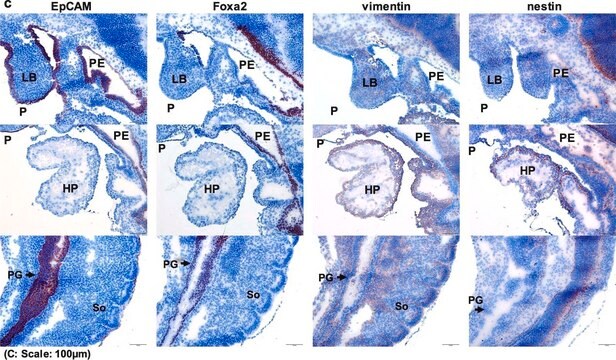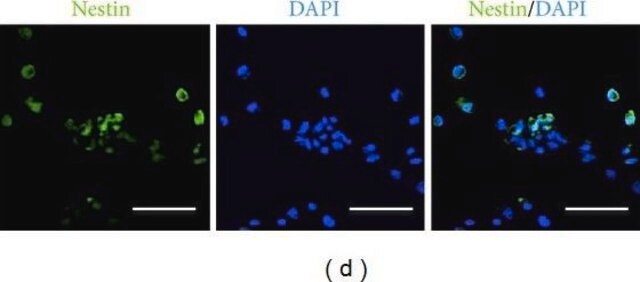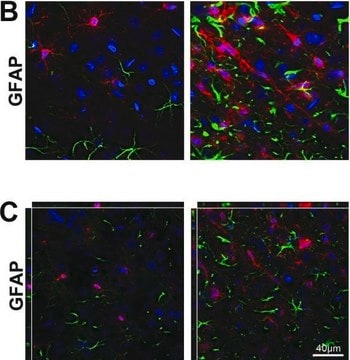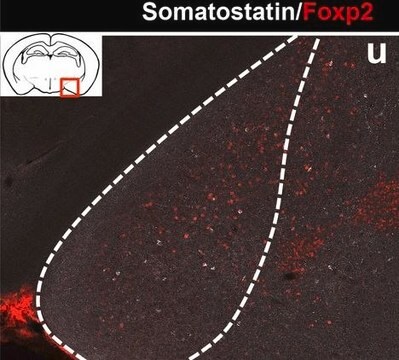MAB353
Anti-Nestin Antibody, clone rat-401
clone rat-401, Chemicon®, from mouse
Synonym(s):
rat401
About This Item
Recommended Products
biological source
mouse
Quality Level
antibody form
purified antibody
antibody product type
primary antibodies
clone
rat-401, monoclonal
species reactivity
mouse, rat
should not react with
human
manufacturer/tradename
Chemicon®
technique(s)
immunocytochemistry: suitable
immunohistochemistry (formalin-fixed, paraffin-embedded sections): suitable
western blot: suitable
input
sample type neural stem cell(s)
sample type epithelial cells
isotype
IgG1
NCBI accession no.
UniProt accession no.
shipped in
wet ice
target post-translational modification
unmodified
Gene Information
human ... NES(10763)
mouse ... Nes(18008)
rat ... Nes(25491)
General description
Specificity
Immunogen
Application
Stem Cell Research
Neural Stem Cells
200-220 kDa in reducing gels of newborn rat or mouse cell extracts. Note that nestin was originally reported (erroneously) to migrate at approximately 440 kDa by SDS-PAGE (Kachinsky, 1995).
For Westerns, prepare samples by boiling in 4 volumes of 125 mM Tris, pH 6.8, 10% 2-mercaptoethanol, 10% glycerol and 4.6% SDS. 5% PAGE gels are suggested. Block membranes with milk or BSA. Do not dilute primary antibody in buffer containing milk. Freezing and thawing of samples or samples not stored at -85°C will show breakdown of nestin sometimes into multiple fragments.
Immunohistochemistry:
1:20-1:200 dilution of a previous lot was used. Perfuse tissue with 4% paraformaldehyde at pH 7.4 for light microscopy or with either 4% paraformaldehyde at pH 10.0 or 4% paraformaldehyde with 0.1% glutaraldehyde at pH 7.4 for EM. Suitable for frozen or paraffin-embedded sections.
Immunocytochemistry:
1:20-1:200 dilution of a previous lot was used. Fix cells in 4% paraformaldehyde buffered with 50 mM sodium borate at pH 9.5.
Optimal working dilutions and protocols must be determined by end user.
Quality
Nestin (cat. # MAB353, Clone 401) staining of Mouse Pancreas, tissue was pretreated with citrate buffer, pH 6.0. A previous lot of this antibody was diluted to 1.25 µg/mL, using IHC-Select detection with HRP-DAB. Immunoreactivity is detected in the islets of Langerhans.
Optimal Staining of Nestin Monoclonal Antibody: Mouse Pancreas
Target description
Physical form
Storage and Stability
Analysis Note
Mouse embryonic brain tissue
Other Notes
Legal Information
Disclaimer
Not finding the right product?
Try our Product Selector Tool.
Storage Class Code
12 - Non Combustible Liquids
WGK
WGK 1
Flash Point(F)
Not applicable
Flash Point(C)
Not applicable
Certificates of Analysis (COA)
Search for Certificates of Analysis (COA) by entering the products Lot/Batch Number. Lot and Batch Numbers can be found on a product’s label following the words ‘Lot’ or ‘Batch’.
Already Own This Product?
Find documentation for the products that you have recently purchased in the Document Library.
Articles
Human iPSC neural differentiation media and protocols used to generate neural stem cells, neurons and glial cell types.
Protocols
Step-by-step culture protocols for neural stem cell culture including NSC isolation, expansion, differentiation and characterization.
Our team of scientists has experience in all areas of research including Life Science, Material Science, Chemical Synthesis, Chromatography, Analytical and many others.
Contact Technical Service








